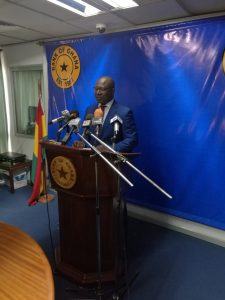
The Monetary Policy Committee (MPC) of the Bank of Ghana (BoG) has decided to reduce the money policy rate by 200 basis points to 23.5 percent.
The Governor of BoG, Dr Abdul Nasir Issahaku who announced this in Accra today cited easing inflation pressures, recovery of the Cedi, among others.
“The MPC noted that underlying inflation pressures have eased considerably and inflation is projected to trend downed towards the medium term target”, he explained.
However, Dr Issahaku said; “there are indications that growth is likely to remain significantly below potential, which alongside an improved inflation outlook provides some scope for monetary policy easing”.
The policy rate is the rate at which the BoG does overnight lending to the commercial banks. With this reduction, it is expected that all the banks in the country should reduce their base rates.
He noted : “Headline inflation declined for the fifth consecutive month in February 2017. Inflation fell from 17.2 percent in September 2016 to 15.4 percent in December and further down to 13.2 percent in February 2017”.
The steady decline in consumer prices reflected in both food and non-food prices, driven mainly by the tight monetary policy stance and some base effects. Core inflation (CPI inflation excluding energy and utility prices) similarly eased over the period.
Inflation expectations across all sectors, that is, consumers, businesses and the financial sector broadly declined. These trends imply dampening of underlying inflation pressures, according to him.
The Bank’s latest forecasts indicate a continued downward trend towards the medium term inflation target of 8±2 March 27, 2017 Bank of Ghana Monetary Policy Committee Press Release 2 percent in 2018.
However, upside risks to the inflation outlook remain the impact of tighter global financial conditions and volatility in commodity prices.
Dr Issahaku who is also the Chairman of the MPC add that economic growth was generally modest in 2016. However, the Bank’s latest update of the Composite Index of Economic Activity (CIEA) registered an uptick in year-on-year terms driven mainly by exports, port activities and private sector credit growth.
In addition, the consumer and business confidence indices reflected positive sentiments about economic and industry prospects. The fiscal outturn for 2016 showed a higher deficit than targeted.
The overall provisional budget deficit was 8.7 percent of GDP against a target of 5.0 percent, financed mainly from domestic sources. The fiscal slippage was attributed to both expenditure overruns and revenue shortfalls.
The 2017 budget has signaled a return to the path of fiscal consolidation with a projected deficit of 6.5 percent of GDP based on improved revenue mobilisation and controlled expenditures.
The global economy is projected to pick up moderately in 2017 driven largely by the expected fiscal stimulus in the US as well as recovery in the eurozone and emerging market economies.
These projections may prompt a faster pace of monetary policy normalisation and in turn, further tightening of global financing conditions. In addition, there remains considerable uncertainty in the international commodities market.
These developments could adversely impact Ghana’s balance of payments, exchange rate and the inflation outlook. The external sector performance continues to improve, Dr Issahaku stated.
“Provisional estimates of the trade account through February 2017 recorded a surplus, largely due to higher export receipts and lower non-oil imports. For the same period, gross foreign assets increased to an equivalent of 3.7 months of import cover, up from 3.5 months in December 2016”.
The foreign exchange market witnessed increased pressures in the year to early March, partly attributed to a strengthening US dollar, seasonal demand factors and speculative activities.
However, the observed pressures have significantly eased in recent weeks on the back of renewed confidence in the economy and improved foreign exchange inflows.
As at 24th March, 2017, the Ghana cedi had cumulatively depreciated by 3.5 percent against the US dollar, significantly recovering from 8.8 percent depreciation recorded by 8th March.
African Eye Report


